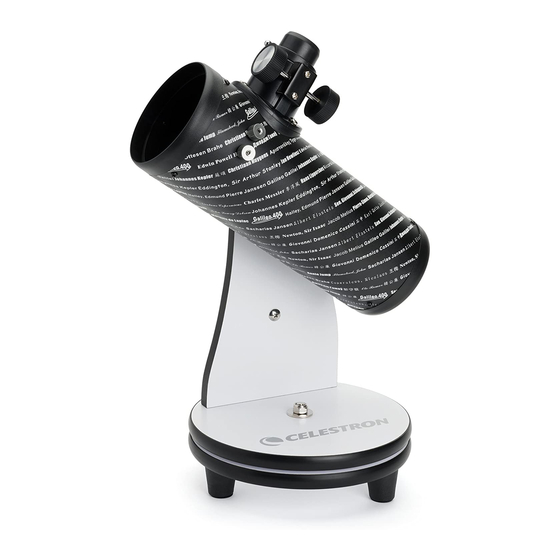Subscribe to Our Youtube Channel
Summary of Contents for Celestron FirstScope 21024
- Page 1 – –...
-
Page 2: Table Of Contents
Table of Contents INTRODUCTION .......................... 3 ASSEMBLY ........................... 5 Installing the Eyepieces ......................5 Pointing the Telescope........................ 5 TELESCOPE BASICS ........................6 Image Orientation ........................6 Focusing............................7 Calculating Magnification ......................7 Determining Field of View ......................7 General Observing Hints......................7 The Celestial Coordinate System.................... -
Page 3: Introduction
Congratulations on your purchase of the FirstScope telescope. The FirstScope uses a Dobsonian Mount which is a simple, easy to use type – easy movement of altitude (up & down) and azimuth (side-to-side). The optical tube is a Newtonian reflector design. The FirstScope is made of the highest quality materials to ensure stability and durability. - Page 4 Figure 1-1 Focuser Secondary (Diagonal) Mirror-- inside Tube End Optical Tube Primary Mirror -- inside Lock Nut Focus Knob Base Eyepiece...
-
Page 5: Assembly
Your telescope requires virtually no assembly. The telescope with its optical tube and mount are preassembled and almost ready to use when taken out of the carton. Two eyepieces are included – 20mm (15 power) and a 4mm (75 power). Insert an eyepiece and you are ready to use the telescope. -
Page 6: Telescope Basics
A telescope is an instrument that collects and focuses light. The nature of the optical design determines how the light is focused. Some telescopes, known as refractors, use lenses, and other telescopes, known as reflectors (Newtonians), use mirrors. A Newtonian reflector uses a single concave mirror as its primary. Light enters the tube traveling to the mirror at the back end. -
Page 7: Focusing
To focus your FirstScope telescope, simply turn the focus knob located directly below the eyepiece. Turning the knob clockwise allows you to focus on an object that is farther than the one you are currently observing. Turning the knob counterclockwise from you allows you to focus on an object closer than the one you are currently observing. -
Page 8: The Celestial Coordinate System
Up to this point, this manual covered the assembly and basic operation of your telescope. However, to understand your telescope more thoroughly, you need to know a little about the night sky. This section deals with observational astronomy in general and includes information on the night sky and polar alignment. For telescopes with equatorial mounts, the users have setting circles and polar alignment methods to help them find objects in the sky. -
Page 9: Motion Of The Stars
The daily motion of the Sun across the sky is familiar to even the most casual observer. This daily trek is not the Sun moving as early astronomers thought, but the result of the Earth's rotation. The Earth's rotation also causes the stars to do the same, scribing out a large circle as the Earth completes one rotation. -
Page 10: Celestial Observing
See the "Seeing Conditions" section later in this section. To increase contrast and bring out detail on the planetary surface, try using Celestron eyepiece filters. Deep-sky objects are simply those objects outside the boundaries of our solar system. They include star clusters, planetary nebulae, diffuse nebulae, double stars and other galaxies outside our own Milky Way. - Page 11 Star Hopping One convenient way to find deep-sky objects is by star hopping. Star hopping is done by using bright stars to "guide" you to an object. For successful star hopping, it is helpful to know the field of view of your telescope. If you’re using the standard 20mm eyepiece with the FirstScope telescope, your field of view is approximately 2.7º.
- Page 12 Star hopping to the Andromeda Galaxy (M31) is a snap, since all the stars needed to do so are visible to the naked eye. Star hopping will take some getting used to and objects that don’t have stars near them that are visible to the naked eye are challenging.
-
Page 13: Seeing Conditions
Viewing conditions affect what you can see through your telescope during an observing session. Conditions include transparency, sky illumination, and seeing. Understanding viewing conditions and the effect they have on observing will help you get the most out of your telescope. Transparency Transparency is the clarity of the atmosphere which is affected by clouds, moisture, and other airborne particles. -
Page 14: Telescope Maintenance
NOT sealed, the covers should be placed over the openings when not in use. This will prevent contaminants from entering the optical tube. Internal adjustments and cleaning should be done only by the Celestron repair department. If your telescope is in need of internal cleaning, please call the factory for a return authorization number and price quote. - Page 15 Aligning the Secondary Mirror If you have an eyepiece in the focuser, remove it. Rack the focuser tube in completely, using the focusing knobs, until its silver tube is no longer visible. You will be looking through the focuser at a reflection of your eye in the secondary mirror superimposed on the primary mirror (Figure 6-2).
-
Page 16: Optional Accessories
To enhance the enjoyment of your FirstScope, Celestron offers a FirstScope Accessory Kit (# 21024-ACC) and also various other accessory items. Details are available on the Celestron website. Model # 21024 FirstScope Specifications Optical Design Newtonian reflector Aperture 76mm (3.0")


















Need help?
Do you have a question about the FirstScope 21024 and is the answer not in the manual?
Questions and answers